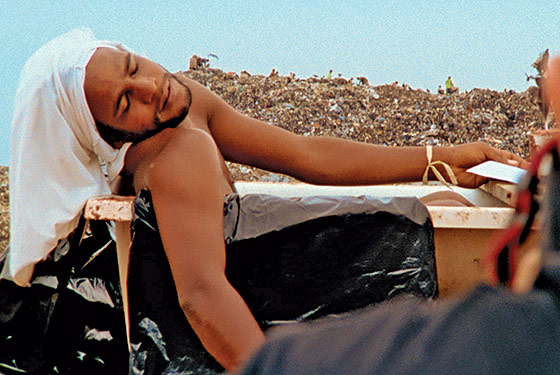
The catadores of Brazil spend their days in what you might consider hell. They comb through the world’s largest landfill—Rio de Janeiro’s Jardim Gramacho—recycling 200 tons of garbage daily. It’s filthy, poorly paid, often dangerous work (the area is ruled by warring drug gangs). They are, in effect, the refuse of Brazilian society.
Roughly 5,000 miles away, in Brooklyn, lives another Brazilian, Vik Muniz. Born poor in São Paulo, he could have ended up in Gramacho, except for an almost ludicrous fluke: In 1983, he was accidentally shot in the leg. The shooter turned out to be rich and gave Muniz enough money to fund a life-transforming trip to New York. He’s now a museum-collected artist who specializes in humorous, unorthodox approaches—a highbrow recycler, of ideas and materials (as in his memorable re-creation of The Last Supper out of Bosco chocolate syrup). The documentary filmmaker Lucy Walker (Countdown to Zero) was a fan of Muniz’s work, and she approached him about a collaboration. “I was obsessed with the fact that Vik had grown up poor, but he’d gotten lucky. The catadores haven’t been lucky—they’ve lost everything.” Together they conceived a project around the question Can art change people?
The deeply moving result is the documentary Waste Land, which chronicles Muniz’s three years of making surprisingly powerful portraits of, and with, six catadores—combinations of photography, drawing, and garbage (profits from sales of these—$300,000 to date—goes back to the catadores). The most compelling of the six subjects is Tião Santos, a poetic 28-year-old who, against significant odds, created the first organization devoted to improving the lives of Gramacho’s garbage pickers, after educating himself with novels and political texts found at the dump—everything from Moby-Dick to Machiavelli’s The Prince (he asked to be photographed as eighteenth-century radical journalist Jean-Paul Marat, above). “Tião was comparing Machiavelli to his own life—the fortified hills of sixteenth-century Italy to the warring drug lords of Rio,” says Walker. “Which was such an apropos comparison—the most astute I’ve heard.”
After shooting at Gramacho all day, Walker and her crew would head into Rio, to eat and drink with the city’s rich, sophisticated elite. “Those people all wanted things—more and more! But when we asked the people living in garbage what they wanted, their first response was that they had everything they needed,” says Walker. “The women could easily have turned to prostitution, the men to crime or drug dealing. They chose garbage, where the only person you hurt is yourself. We fell in love with them, with their dignity. It reminded me of a line in Cool Hand Luke: ‘Sometimes nothin’ can be a real cool hand.’ ”
Waste Land
Arthouse Films. NR.